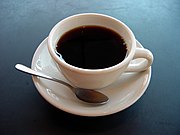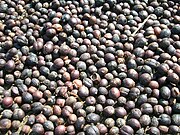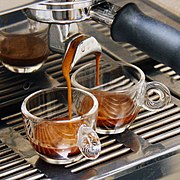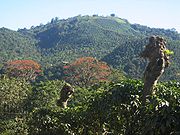កាហ្វេ
From Wikipedia
កាហ្វេ គឺជាភេសជ្ជៈដែលបានប្រើប្រាស់យ៉ាងទូលំទូលាយ រៀបចំឡើងដោយ គ្រាប់កាហ្វេ លីង ជាទូទៅត្រូវបានស្គាល់ជា គ្រាប់ នៃដើមកាហ្វេ។ វាអាចញ៉ាំក្ដៅ ឬត្រជាក់។ A typical 200 ml (7 fluid ounces) cup of coffee contains 80–140 milligrams of caffeine, depending on the bean and method of roasting and preparation.[១] Some people drink coffee "black" (plain), while others sweeten their coffee or add milk, cream or non-dairy creamer. The majority of all caffeine consumed worldwide comes from coffee, as much as 85% in some countries.[២] Coffee, along with tea and water, is one of the most popular beverages world-wide, its volume amounting to about a third of that of tap water in North America and Europe.[៣] In 2003, coffee was the world's sixth largest agricultural export in value, behind wheat, maize, soybeans, palm oil and sugar.[៤]
Contents |
[កែប្រែ] ដើមកំណើតពាក្យ
ពាក្យ "កាហ្វេ" ជាភាសាអង់គ្លេស ត្រូវបានជឿរជាក់យ៉ាងមុតមាំថាចេញមកពីឈ្មោះនៃទីកន្លែង 'kaffa' នៅ អេធីយ៉ូភាខាងត្បូង ជាកន្លែងដែល កាហ្វេ ប្រមូលផល។ វាត្រូវបានហៅថា būnn (ቡን) ឬ būnnā (ቡና) នៅ អេធីយ៉ូភា ក្នុង អាំហារិក និង būnnī (ቡኒ) នៅ ទីហ្គ្រីយ៉ា និងភាសាផ្សេងៗជា būnn ដើម។ ឈ្មោះកាហ្វេរបស់ អារ៉ាប់ qahwa (قهوة), គឺជាពាក្យកាត់នៃ qahwat al-būnn ឬ ស្រានៃសណ្ដែក។
qahhwaរបស់អារ៉ាប់ ត្រូវបានខ្ចីដោយ Ottoman Turkish ជា kahveដែលត្រូវបានខ្ចីបន្តទៅជា Italian ជា caffè ជាមួយនឹង French Portuguese និង Spanish ជា café។[៥] ទម្រង់ដំបូងទាក់ទងទៅនឹងទសវត្សរ៍មុន នៃសតវត្សរ៍ទី ១៦ ប៉ុន្តែពាក្យ "កាហ្វេ" ផ្ទាល់មិនត្រូវបានប្រើ រហូតដល់ពាក់កណ្ដាលឆ្នាំ ១៦០០។[៦]។
[កែប្រែ] ប្រវត្ដិកាហ្វេ
Template:Main
ប្រវត្ដិរបស់កាហ្វេអាចត្រូវបានតាមដាន យ៉ាងហោចណាស់នៅដើមសតវត្សទី៩ នៅពេលវាលេចរូបរាងឡើងនៅតំបន់ខ្ពង់រាបអេធីយ៉ូភា។ លោក Shepherds គឺជាអ្នករកឃើញដំបូងគេនូវឥទ្ធិពលនៃសារជាតិញាណពីគ្រាប់កាហ្វេ, after their goats consumed some naturally occurring coffee beans in the pasture, the goats appeared to "dance" and have an increased level of energy. From Ethiopia, it spread to Egypt and Yemen,[៧] and by the fifteenth century had reached Persia, Turkey, and northern Africa.
From the Muslim world, coffee spread to Europe, and became popular there during the seventeenth century. The Dutch were the first to import it large-scale into Europe, and eventually smuggled in some seedlings in 1690, defying the Arab prohibition on exporting the plants or unroasted seeds. The Dutch later grew the crop in their colony of Java.[៨] In 1583, Leonhard Rauwolf, a German physician, after returning from a ten-year trip to the Near East, gave this description of coffee:[៩][១០] Template:Cquote
When coffee reached the American colonies, it was initially not as successful as it had been in Europe, as colonists found it a poor substitute for alcohol. However, during the Revolutionary War, the demand for coffee increased so much that dealers had to hoard their scarce supplies and raise prices dramatically; this was partly owing to the reduced availability of tea from British merchants. After the War of 1812, in which Britain had temporarily cut off access to tea imports, the Americans' taste for coffee grew during the early nineteenth century, and high demand during the American Civil War together with the advancements of brewing technology secured the position of coffee as an everyday commodity in the United States. Today coffee is a common beverage of the North American breakfast and morning commute.
[កែប្រែ] The plant
[កែប្រែ] Coffee seed types
Template:Main
There are two main species of the coffee plant, the older one being Coffea arabica. Coffee is thought to be indigenous to south-western Ethiopia, specifically from Kaffa, from which it may have acquired its name.[១១] While more susceptible to disease, it is considered by most to taste better than the second species, Coffea canephora (robusta). Robusta, which contains about 40–50% more caffeine, can be cultivated in environments where arabica will not thrive and probably originated in Uganda.[១១] For this reason it is used as an inexpensive substitute for arabica in many commercial coffee blends. Compared to arabica, robusta tends to be bitter and has little flavor, with a telltale "burnt rubber" or "wet cardboard" aroma and flavor. Good quality robustas are used in some espresso blends to provide a better "crema" (foamy head), and to lower the ingredient cost. In Italy, many espresso blends are based on dark-roasted robusta. The large industrial roasters use a steam treatment process to remove undesirable flavors from robusta beans for use in mass-marketed coffee blends.[១២] Other species include Coffea liberica and Coffea esliaca, believed to be indigenous to Liberia and southern Sudan respectively.[១១]
Arabica coffees were traditionally named by the port from which they were exported, the two oldest being Mocha, from Yemen, and Java, from Indonesia. The modern coffee trade is much more specific about origin, labeling coffees by country, region, and sometimes even the producing estate. Varietal[១៣] is a botanical term denoting a taxonomic category ranking below species, a designation more specific than arabica or robusta and unrelated to the coffee's place of origin. Coffees consisting entirely of beans from a single varietal, bourbon, for example, are generally so referred to, with a reference to their place of origin (as in: Rwanda Blue Bourbon). Coffee aficionados may even distinguish auctioned coffees by lot number.[១៤]
Most arabica coffee beans originate from one of three growing regions; Latin America, East Africa/Arabia and Asia/Pacific. Beans from different countries or regions usually have distinctive characteristics such as flavour (flavour criteria include terms such as "citrus-like" or "earthy"), aroma (sometimes "berry-like" or "flowery"), body or mouthfeel, and acidity. Acidity refers to a tangy or clean-tasting quality, typically present in washed or wet processed coffees. It does not refer to a coffee's pH level. (Black coffee has a pH of around 5).[១៥] These distinguishing taste characteristics are dependent not only on the coffee's growing region, but also on its method of process and genetic subspecies or varietal.[១៦][១៧]
A peaberry, (also sometimes called a "Caracoli" bean[១៨]) is a coffee bean that develops singly inside the coffee cherry instead of the usual pair of beans. This situation occurs 5–10% of the time. Since flavour is concentrated when only a single bean is grown inside the cherry, these beans (especially Arabica) are highly prized.[១៩]
[កែប្រែ] The drink
[កែប្រែ] វិធីធ្វើ និង ការលីង
Template:Main ដំណើរការជាច្រើន និង ពលកម្មរបស់មនុស្សជាតម្រូវការដ៏ចាំបាច់ មុនពេលដែលផ្លែកាហ្វេ និងគ្រាប់វាត្រូវយកមកធ្វើជាកាហ្វេលីង ដែលពួកលោកខាងលិចជំនាញ។ ផ្លែកាហ្វេត្រូវតែបេះ ហាល បែងចែក ហើយដំណើរការខ្លះឈានដល់យូរឆ្នាំ។[១០]
កាហ្វេជាទូទៅត្រូវបានលក់ជាលីងស្រាប់ ហើយ វិធី លីង នោះត្រូវបានចាត់ទុកជាវិច្ច័យដែលជះឥទ្ធិពលយ៉ាងខ្លាំងដល់រស់ជាតិនៃផលិតផល។ កាហ្វេទាំងអស់ត្រូវតែលីងមុននឹងយកមកប្រើ។ នៅពេលគ្រាប់កាហ្វេត្រូវបានលីង វានឹងប្រែពណ៏ងងឹតជាងមុនពីព្រោះវា ឡើងជាតិស្ករ។ កាហ្វេត្រូវបានដាក់លក់ លីងស្រាប់ ដោយអ្នកលក់ តែវាក៏អាច លីងដោយខ្លួនឯង។[១០]
ការលីងកាហ្វេគឺជាវិធីដែលស្មុគស្មាញមួយ ដែលបង្កើតរសជាតិកាហ្វេពីសណ្ដែកធម្មតា។ គ្រាប់មិនទាន់លីងមានជាតិអាស៊ីត ប្រូតេអ៊ីន និង កាហ្វេអ៊ីន ប៉ុន្តែគ្មានមួយណាដែលមានរសជាតិទេ។ វាត្រូវការកម្ដៅដើម្បីចាប់ផ្ដើមប្រតិកម្មគីមី ដែលប្ដូរ កាបូអ៊ីដ្រាត និង ខ្លាញ់ទៅជា ប្រេងឈ្ងុយ ដុតចោលសំណើម និង កាបូនឌីអុកស៊ីដ ហើយកម្ទេច និងបង្កើតអាស៊ីត បញ្ចេញសារធាតុ រសជាតិ កាហ្វេ។[១០] ប្រេងក្នុងចំណោមប្រេងឈ្ងុយគឺ caffeol ដែលទទូលខុសត្រូវលើ ក្លិន និងរសជាតិកាហ្វេ។[៨]
បំបាត់ជាតិកាហ្វេអ៊ីន ត្រូវបានធ្វើឡើងដោយក្រុមហ៊ុនផលិត ហើយជាតិកាហ្វេអ៊ីនដែលបានយកចេញ ត្រូវបានលក់ទៅឧស្សាហកម្មឧសថ។[៨]
[កែប្រែ] Preparation
Template:Main The processing of coffee typically designates the agricultural and industrial processes needed to deliver whole roasted coffee beans to the consumer. Grinding the roasted coffee beans is done at a roastery, in a grocery store, or at home. It is most commonly ground at the roastery and sold to the consumer ground and packaged, though "whole-bean" coffee that is ground at home is becoming more popular, despite the extra effort required. A grind is referred to by its brewing method. "Turkish" grind, the finest, is meant for mixing straight with water, while the coarsest grinds, such as coffee percolator or French press, are at the other extreme. Midway between the extremes are the most common: "drip" and "paper filter" grinds, which are used in the most common home coffee brewing machines. The "drip" machines operate with near-boiling water passed in a slow stream through the ground coffee in a filter. The espresso method uses more advanced technology to force very hot (pressurized, not boiling) water through the ground coffee, resulting in a stronger flavor and chemical changes with more coffee bean matter in the drink. Once brewed, it may be presented in a variety of ways: on its own, with sugar, with milk or cream, hot or cold, and so on. Roasted arabica beans are also eaten plain and covered with chocolate. See the article on coffee preparation for a comprehensive list.
A number of products are sold for the convenience of consumers who do not want to prepare their own coffee . Instant coffee has been dried into soluble powder or freeze dried into granules, which can be quickly dissolved in hot water for consumption. Canned coffee is a beverage that has been popular in Asian countries for many years, particularly in Japan and South Korea. Vending machines typically sell a number of varieties of canned coffee, available both hot and cold. To match the often busy life of Korean city dwellers, companies mostly have canned coffee with a wide variety of tastes. Japanese convenience stores and groceries also have a wide availability of plastic-bottled coffee drinks, which are typically lightly sweetened and pre-blended with milk. Lastly, liquid coffee concentrate is sometimes used in large institutional situations where coffee needs to be produced for thousands of people at the same time. It is described as having a flavor about as good as low-grade robusta coffee, and costs about 10 cents a cup to produce. The machines used to process it can handle up to 500 cups an hour, or 1,000 if the water is preheated.[២០]
[កែប្រែ] Caffeine content
Depending on the type of coffee and method of preparation the caffeine content of a cup of coffee can vary greatly. However, on average the following amounts of caffeine can be expected in a single serving. A serving is 7 fluid ounces (about 207 milliliters) except for espresso.[២១][២២]
- drip coffee: 115–175 mg
- espresso: 100 mg (serving size: one shot, 1.5–2 oz)
- brewed: 80–135 mg
- instant: 65–100 mg
- decaf, brewed: 3–4 mg
- decaf, instant: 2–3 mg
[កែប្រែ] Tasting
Template:Main Coffee tasting, also known as coffee cupping, is the practice of experiencing the tastes and aromas of brewed coffee. Although it is a professional practice, it can be done by anyone. The taster deeply sniffs the coffee, and then loudly slurps it so that it spreads to the back of the tongue. Then he attempts to measure aspects of the coffee's taste, specifically the body (the texture or mouthfeel, such as oiliness), acidity (a sharp and tangy feeling, like when biting into an orange), and balance (the harmony of flavours working together). Since coffee beans embody telltale flavours of the region in which they were grown, tasters may attempt to determine the coffee's origin.
[កែប្រែ] កាហ្វេជាមួយអាហារ
ជាទូទៅកាហ្វេត្រូវបានរៀបចំជាមួយអាហារ ឬ ជាចំណែកមួយនៃ អាហារពេលព្រឹក។ ជាផ្លូវការជាងនេះ ដូចជានៅតាមភោជនីដ្ឋាន កាហ្វេត្រូវបានផ្ដល់ក្នុងពេល បង្អែម ក្រោយពេលញ៉ាំអាហារធំ។
ជួនកាលកាហ្វេត្រូវបានរៀបចំជាភេសជ្ជៈនៅចន្លោះអាហារ ភាគច្រើនមានជាមួយនឹង អាហារត្រជាក់ៗ ផ្អែមៗ ដែលរួមមានដូចជា នំប៉ាសស្ទ្រី, នំប៉័ង, នំប្រៃ, នំបារាំង ហើយនៅ អាមេរិកខាងជើង នំបារាំងកាហ្វេ (មានឈ្មោះអញ្ចឹងព្រោះភាគច្រើនត្រូវញ៉ាំជាមួយកាហ្វេ មិនមែនមកពីមានជាតិកាហ្វេទេ)។
[កែប្រែ] Coffee and society
[កែប្រែ] Social aspects of coffee
- See also: Coffeehouse for a social history of coffee, and caffè for specifically Italian traditions.
Template:Main Coffee plays an important role in many societies throughout the world today. From the coffeehouses of the 16th century to modern day cafés, coffee has had a profound effect on the lifestyles of people from all walks of life. When it first appeared in Africa and Yemen, it was commonly used as a type of religious intoxicant. This usage in religious rites among the Sufi branch of Islam led to it being put on trial in Mecca for being a "heretic" substance much as wine was. It was briefly repressed, and was later part of a larger ban in Ottoman Turkey under an edict that led to the death of thousands of people.[២៣] Its early association in Europe with rebellious political activities led to its banning in England, among other places.[២៤]
In India the Indian Coffee Houses became an icon of the worker's struggle. This restaurant chain is now owned by the workers of ICHs, as a result of the struggle performed by the thrown-out workers from the Coffee Houses of Coffee Board. This struggle was led by famed Communist leader of India A. K. Gopalan. The ICHs became the meeting places of leftists in India later.
In Nordic countries, coffee parties are a popular, informal kind of home entertainment. In Swedish culture, coffee plays an extremely important role as a social lubricant through a process known as fika, or a leisurely coffee break — perhaps even more so than in other coffee-drinking cultures.[២៥]
[កែប្រែ] Coffee in religions
In ancient times, coffee was initially used for spiritual reasons. At least 1,000 years ago, traders brought coffee across the Red Sea into Arabia (modern-day Yemen), where Muslim monks began cultivating the shrubs in their gardens. At first, the Arabians made wine from the pulp of the fermented coffee berries. Thus coffee became known as "Qahwah," which is the Arabic word for wine, from which the modern word coffee derives. This beverage was known as "Qishr" ("Kisher" in modern usage) and was used during religious ceremonies. Coffee became the substitute beverage in spiritual practice in place of wine where wine was forbidden.[២៦]
Coffee drinking was briefly prohibited to Muslims as "haraam" in the early years of the 16th century, but this was quickly overturned. Later, regarded as a "Muslim drink", it was prohibited to Ethiopian Orthodox Christians (along with khat and tobacco) up until as late as around 1900. This fact is not widely known today, as it is now considered a national drink of Ethiopia, for people of all faiths.
Another example of coffee prohibition can be found in The Church of Jesus Christ of Latter-day Saints (Latter-day Saints or Mormons), being the only major religion in the world (about 12.5 million followers world-wide) that defines a doctrine of complete coffee abstinence. The Church of Latter-Day Saints claims that it is both physically and spiritually unhealthy to consume coffee.[២៧] The Mormon doctrine of health given February 27, 1833 does not specifically identify caffeine as the reason for avoiding hot drinks, nor does it identify coffee by name, but was introduced by Mormon founder Joseph Smith, in a revelation called the Word of Wisdom, which includes the statement that "hot drinks are not for the belly." (Doctrine & Covenants Section 89). This was later interpreted to mean coffee or tea.
[កែប្រែ] Health and pharmacology of coffee
Template:Main Many studies have been performed on the relationship between coffee consumption and many medical conditions, ranging from diabetes and cardiovascular disease to cancer and cirrhosis. Studies are contradictory as to whether coffee has any specific health benefits, and results are similarly conflicting with respect to negative effects of coffee consumption.[២៨] While some health effects are those of the caffeine, others appear to be due to other components of the coffee.
One fairly consistent finding has been the reduction of diabetes mellitus type 2 in coffee consumers, an association that cannot be explained by the caffeine content alone and indeed may be stronger in decaffeinated coffee.[២៩]
Recently, coffee was found to reduce the chances of developing cirrhosis of the liver: the consumption of 1 cup a day was found to reduce the chances by 20%, and 4 cups a day reduced the chances by 80%.[៣០]
There exists research to suggest that drinking caffeinated coffee can cause a temporary increase in the stiffening of arterial walls.[៣១]
Excess coffee consumption may lead to a magnesium deficiency or hypomagnesemia,[៣២] which may contribute to, or explain, many of the diseases or effects caused by overconsumption.Template:Fact
[កែប្រែ] Economics of coffee
Template:Main Coffee is one of the world's most important primary commodities due to being one of the world's most popular beverages. In total, 6.7 million tonnes of coffee were produced annually in 1998–2000, and the forecast is a rise to 7 million tonnes annually by 2010.[៣៣] Coffee also has several types of classifications used to determine environmental and labor standards.
Brazil remains the largest coffee exporting nation, but in recent years the green coffee market has been flooded by large quantities of robusta beans from Vietnam.[៣៤] Many experts believe the giant influx of cheap green coffee after the collapse of the International Coffee Agreement of 1975–1989 with Cold War pressures led to the prolonged pricing crisis from 2001 to 2004.[៣៥] In 1997 the "c" price of coffee in New York broke US$3.00/lb, but by late 2001 it had fallen to US$0.43/lb.[៣៦]
Robusta coffees (traded in London at much lower prices than New York's Arabica) are preferred by large industrial clients (multinational roasters, instant coffee producers, etc.) because of their lower cost.
The farmers in many parts of the Third World responded to the price crash by forming co-ops to bargain on the world market. This was responsible for major coffee companies agreeing to pay 3-4 times the price of coffee that they were paying the individual farmers.[៣៧]
Four single roaster companies buy more than 50% of all of the annual production: Kraft, Nestlé, Procter & Gamble, Sara LeeTemplate:Facts. The preference of the "Big Four" coffee companies for cheap robusta is believed by many to have been a major contributing factor to the crash in coffee prices,[៣៨] and the demand for high-quality arabica beans is only slowly recovering. After the crash, many coffee farmers in Africa, Indonesia and South and Central America lost their livelihoods, or turned to illicit crops such as coca to earn a living. The Dutch brand 'Max Havelaar' started the concept of fair trade labeling, which attempted to remedy the situation by guaranteeing coffee growers a negotiated pre-harvest price.[៣៩] Another issue with coffee is ecological: the American Birding Association has led a campaign for sustainably harvested, shade-grown and organic coffees vs. the newer mono-cropped full-sun varieties, which lead to deforestation and loss of bird habitat.[៤០]
Coffee ingestion on average is about a third that of tap water in most of North America and Europe.[៣] The United States consumes around six billion gallons of coffee a year.[៤១] In 2002 in the U.S., average coffee consumption was 22.1 gallons per person.[៤២]
[កែប្រែ] Other uses
[កែប្រែ] Coffee in art
- Latte art involves designs in the foam of espresso-based drinks.
- Arfé is the use of coffee as a coloring for painting or other visual effects.
- J. S. Bach composed the humorous Coffee Cantata, about a father annoyed at his daughter's coffee addiction.
[កែប្រែ] Composting
Spent coffee grounds are used as fertilizer in gardens for their acidity and high nitrogen content.[៤៣] Many coffee companies and coffee shops give their used coffee grounds to gardeners for this purpose.[៤៤]
[កែប្រែ] Documentary films about coffee
- Black Harvest (1992)
- Victims of Cheap Coffee (2003)
- Black Coffee (2005)
- Black Gold (2006)
- One Cup (2006)
[កែប្រែ] Notes
Template:Reflist
[កែប្រែ] References
- Allen, Stewart Lee. The Devil's Cup. Random House. ISBN 978-0345441492
- Chambers, Robert (1869). Chambers' Book of Days for January 27, retrieved February 21, 2006.
- Erowid (2006) Caffeine Content of Beverages, Foods, & Medications retrieved October 16, 2002.
- Francis, John K. Coffea arabica L. RUBIACEAE Factsheet of U.S. Department of Agriculture, Forest Service
- Hanauer, J.E. (1907). Folk-lore of the Holy Land.
- Jacob, Heinrich Eduard: Coffee. The Epic of a Commodity. Short Hills: Burford Books, 1998. ISBN 1-58080-070-X. (Introduction: Lynn Alley).
- Kushner, Marina. The Truth About Caffeine. SCR Books. ISBN 978-0974758244
- Mai, Marina. "Boom für die Bohnen"in Jungle World Nr. 1, 2006/January 4, 2006. ISSN 1613-0766. Template:De icon
- Pendergrast, Mark. Uncommon Grounds: The History of Coffee and How It Transformed Our World, Basic Books, 1999. ISBN 0-465-05467-6
- Rauwolf, Léonard. Reise in die Morgenlander. Template:De icon
- United Nations Food and Agriculture Organization. FAOSTAT Agriculture Data Accessed October 31, 2005.
- Villanueva1, et al. (2006) Total and specific fluid consumption as determinants of bladder cancer risk. International Journal of Cancer 118(8):2040–2047
[កែប្រែ] External links
Template:Commons Template:Wikiquote Template:Cookbook
- Coffee & Conservation - Many resources on sustainable coffee, including reviews, especially shade coffee and biodiversity
- Coffee and caffeine health information - A collection of peer reviewed & journal published studies on coffee health benefits is evaluated, cited & summarized.
- Benjamin Joffe-Walt and Oliver Burkeman, The Guardian, 16 September 2005, "Coffee trail" - from Ethiopian village of Choche to London coffee shop
- Coffee on a Grande Scale - Article about the biology, chemistry, and physics of coffee production
- This is Coffee - Short tribute to coffee in the form of a documentary film (1961), made by "The Coffee Brewing Institute". The movie includes some do's and don'ts of making "the perfect cup of coffee" and an overview of different ways to enjoy coffee throughout the world.
Template:CoffeeTemplate:Link FA Template:Link FA Template:Link FA Template:Link FA Template:Link FA













